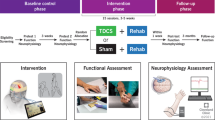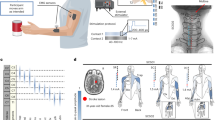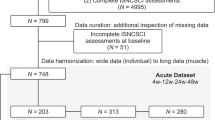Abstract
Study design
Post hoc analysis of prospective multi-national, multi-centre cohort study.
Objective
Determine whether cerebral dominance influences upper extremity recovery following cervical spinal cord injury (SCI).
Setting
A multi-national subset of the longitudinal GRASSP dataset (n = 127).
Methods
Secondary analysis of prospective, longitudinal multicenter study of individuals with cervical SCI (n = 73). Study participants were followed for up to 12 months after a cervical SCI, and the following outcome measures were serially assessed - the Graded Redefined Assessment of Strength, Sensibility, and Prehension (GRASSP) and the International Standards for the Neurological Classification of SCI (ISNCSCI), including upper extremity motor and sensory scores. Observed recovery and relative (percent) recovery were then determined for both the GRASSP and ISNCSCI, based on change from initial to last available assessment.
Results
With the exception of prehension performance (quantitative grasping) following complete cervical SCI, there were no significant differences (p < 0.05) for observed and relative (percent) recovery, between the dominant and non-dominant upper extremities, as measured using GRASSP subtests, ISNCSCI motor scores and ISNCSCI sensory scores.
Conclusion
Despite well documented differences between the cerebral hemispheres, cerebral dominance appears to play a limited role in upper extremity recovery following acute cervical SCI.
Similar content being viewed by others
Log in or create a free account to read this content
Gain free access to this article, as well as selected content from this journal and more on nature.com
or
Data availability
The datasets generated and/or analyzed during the current study are available from the corresponding author on reasonable request.
References
Anderson KD. Targeting recovery: priorities of the spinal cord-injured population. J Neurotrauma. 2004;21:1371–83.
Bradbury EJ, McMahon SB, Bradbury EJ, McMahon SB. Spinal cord repair strategies: why do they work? Nat Rev Neurosci. 2006;7:644–53.
Gutierrez RMS, Ricci NA, Gomes QRS, Oliviera DL, Britto LR, Pires RS. et al. The effects of acrobatic exercise on brain plasticity: a systematic review of animal studies. Brain Struct Funct. 2018;223:2055–71.
Long J, Federico P, Perez MA. A novel cortical target to enhance hand motor output in humans with spinal cord injury. Brain 2017;140:1619–32.
Oudega M, Perez MA. Corticospinal reorganization after spinal cord injury. J Physiol. 2012;590:3647–63.
Turner JA, Lee JS, Schandler SL, Cohen MJ. An fMRI investigation of hand representation in paraplegic humans. Neurorehabil Neural Repair. 2003;17:37–47.
Turner JA, Lee JS, Martinez O, Medlin AL, Schandler SL, Cohen MJ, et al. Somatotopy of the motor cortex after long-term spinal cord injury or amputation. IEEE Trans Neural Syst Rehabil Eng. 2001;9:154–60.
Corbetta M, Burton H, Sinclair RJ, Conturo TE, Akbudak E, McDonald JW, et al. Functional reorganization and stability of somatosensory-motor cortical topography in a tetraplegic subject with late recovery. Proc Natl Acad Sci USA. 2002;99:17066–71.
Mikulis DJ, Jurkiewicz MT, McIlroy WE, Staines WR, Rickards L, Kalsi-Ryan S, et al. Adaptation in the motor cortex following cervical spinal cord injury. Neurology 2002;58:794–801.
Curt A, Bruehlmeier M, Leenders KL, Roelcke U, Dietz V. Differential effect of spinal cord injury and functional impairment on human brain activation. J Neurotrauma. 2002;19:43–51.
Weidner N, Ner A, Salimi N, Tuszynski MH, Weidner N, Ner A, et al. Spontaneous corticospinal axonal plasticity and functional recovery after adult central nervous system injury. Proc Natl Acad Sci USA. 2001;98:3513–8.
Fouad K, Pedersen V, Schwab ME, Brosamle C. Cervical sprouting of corticospinal fibers after thoracic spinal cord injury accompanies shifts in evoked motor responses. Curr Biol. 2001;11:1766–70.
Bruehlmeier M, Dietz V, Leenders KL, Roelcke U, Missimer J, Curt A, et al. How does the human brain deal with a spinal cord injury? Eur J Neurosci. 1998;10:3918–22.
Ghosh A, Haiss F, Sydekum E, Schneider R, Gullo M, Wyss MT, et al. Rewiring of hindlimb corticospinal neurons after spinal cord injury. Nat Neurosci. 2010;13:97–104.
Fehlings MG, Tator CH. The relationships among the severity of spinal cord injury, residual neurological function, axon counts, and counts of retrogradely labeled neurons after experimental spinal cord injury. Exp Neurol. 1995;132:220–8.
Eidelberg E, Straehley D, Erspamer R, Watkins CJ. Relationship between residual hindlimb-assisted locomotion and surviving axons after incomplete spinal cord injuries. Exp Neurol. 1977;56:312–22.
Blight AR. Cellular morphology of chronic spinal cord injury in the cat: analysis of myelinated axons by line-sampling. Neuroscience 1983;10:521–43.
Hammond G. Correlates of human handedness in primary motor cortex: a review and hypothesis. Neurosci Biobehav Rev. 2002;26:285–92.
Haaland KY, Harrington DL. Hemispheric asymmetry of movement. Curr Opin Neurobiol. 1996;6:796–800.
Volkmann J, Schnitzler A, Witte OW, Freund H. Handed-ness and asymmetry of hand representation in human motor cortex. J Neurophysiol. 1998;79:2149–54.
Wassermann EM, McShane LM, Hallett M, Cohen LG. Noninvasive mapping of muscle representations in human motor cortex. Electroencephalogr Clin Neurophysiolol. 1992;85:1–8.
Priori A, Oliviero A, Donati E, Callea L, Bertolasi L, Rothwell JC, et al. Human handedness and asymmetry of the motor cortical silent period. Exp Brain Res. 1999;128:390–6.
Amunts K, Schlaug G, Schleicher A, Steinmetz H, Dabringhaus A, Roland PE, et al. Asymmetry in the human motor cortex and handedness. Neuroimage 1996;4:216–22.
Kooistra CA, Heilman KM. Motor dominance and lateral asymmetry of the globus pallidus. Neurology 1988;38:388–90.
Snyder PJ, Bilder RM, Wu H, Bogerts B, Lieberman JA, Snyder PJ, et al. Cerebellar volume asymmetries are related to handedness: a quantitative MRI study. Neuropsychologia 1995;33:407–19.
Cirillo J, Rogasch NC, Semmler JG. Hemispheric differences in use-dependent corticomotor plasticity in young and old adults. Exp Brain Res. 2010;205:57–68.
Ridding MC, Flavel SC. Induction of plasticity in the dominant and non-dominant motor cortices of humans. Exp Brain Res. 2006;171:551–7.
Velstra IM, Curt A, Frotzler A, Abel R, Kalsi-Ryan S, Rietman JS, et al. Changes in strength, sensation and prehension in acute cervical spinal cord Injury: European Multicenter Responsiveness Study of the GRASSP. Neurorehabil Neural Repair. 2015;29:755–66.
Kalsi-Ryan S, Beaton D, Ahn H, Askes H, Drew B, Curt A, et al. Responsiveness, sensitivity and minimally detectable difference of the graded and redefined assessment of strength, sensibility, and prehension, version 1.0 (GRASSP V1). J Neurotrauma. 2016;33:307–14.
Kalsi-Ryan S, Chan C, Verrier M, Curt A, Fehlings M, Bolliger M. et al. The graded redefined assessment of strength sensibility and prehension version 2 (GV2): psychometric properties. J Spinal Cord Med. 2019;42:149–57. sup1.
Velstra IM, Fellinghauer C, Abel R, Kalsi-Ryan S, Rupp R, Curt A, et al. The graded and redefined assessment of strength, sensibility, and prehension version 2 provides interval measure properties. J Neurotrauma. 2018;35:854–63.
Kirshblum SC, Burns SP, Biering-Sorensen F, Donovan W, Graves DE, Jha A, et al. International standards for neurological classification of spinal cord injury (Revised 2011). J Spinal Cord Med. 2011;34:535–46.
Waters RL, Adkins RH, Sie IH, Yakura JS. Motor recovery following spinal cord injury associated with cervical spondylosis: a collaborative study. Spinal Cord. 1996;34:711–5.
Curt A, Van Hedel HJ, Klaus D, Dietz V. Recovery from a spinal cord injury: significance of compensation, neural plasticity, and repair. J Neurotrauma. 2008;25:677–85.
Kalsi-Ryan S, Beaton D, Curt A, Duff S, Popovic MR, Rudhe C, et al. The graded redefined assessment of strength sensibility and prehension: reliability and validity. J Neurotrauma. 2012;29:905–14.
Christiansen L, Perez MA. Targeted-plasticity in the corticospinal tract after human spinal cord injury. Neurotherapeutics. 2018;15:618–27.
Ditunno JF Jr, Stover SL, Freed MM, Ahn JH. Motor recovery of the upper extremities in traumatic quadriplegia: a multicenter study. Arch Phys Med Rehabil. 1992;73:431–6.
Burns AS, Marino RJ, Flanders AE, Flett H. Clinical diagnosis and prognosis following spinal cord injury. Handb Clin Neurol. 2012;109:47–62.
Acknowledgements
We would like to thank the GRASSP Research and Development Group for providing the resources to conduct this analysis.
Author information
Authors and Affiliations
Contributions
MB contributed to the study design, data analysis, and manuscript preparation. SK contributed to construction of the analyzed data set, and provided feedback during manuscript preparation. JJD contributed to the data analysis. ASB contributed to the study design, data analysis, and manuscript preparation.
Corresponding author
Ethics declarations
Competing interests
The authors declare no competing interests.
Ethical approval
The study utilized a subset of the multinational, longitudinal Graded Redefined Assessment of Strength, Sensibility and Prehension (GRASSP) dataset. Research ethics approval was obtained at contributing sites.
Additional information
Publisher’s note Springer Nature remains neutral with regard to jurisdictional claims in published maps and institutional affiliations.
Rights and permissions
About this article
Cite this article
Bondi, M., Kalsi-Ryan, S., Delparte, J.J. et al. Differences in sensorimotor and functional recovery between the dominant and non-dominant upper extremity following cervical spinal cord injury. Spinal Cord 60, 422–427 (2022). https://doi.org/10.1038/s41393-022-00782-1
Received:
Revised:
Accepted:
Published:
Issue date:
DOI: https://doi.org/10.1038/s41393-022-00782-1
This article is cited by
-
Upper extremity asymmetry due to nerve injuries or central neurologic conditions: a scoping review
Journal of NeuroEngineering and Rehabilitation (2023)
-
Characterizing neurological status in individuals with tetraplegia using transcutaneous spinal stimulation
Scientific Reports (2023)



